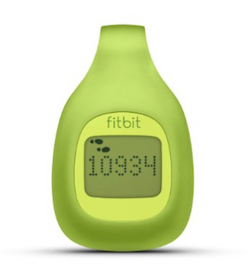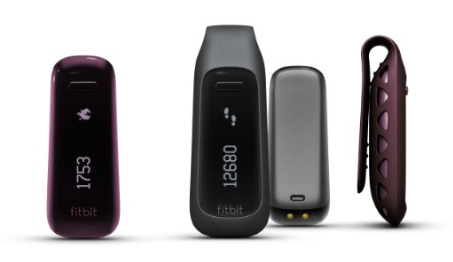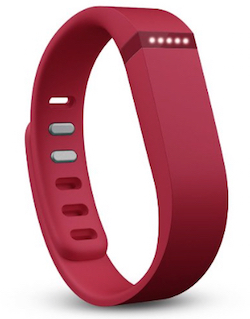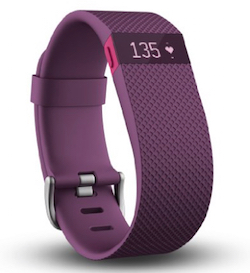
Before I got an Apple Watch, I was a big fan of Fitbit products. The first activity tracker I owned was one of the first Fitbits, which had its own little quirks — it needed frequent charging on a USB-connected stand, you had to put it on its charging stand to sync it, and syncing sometimes would stop working for no apparent reason. Fitbit learned a lot from those early devices, and now has a family of six devices. The company is a leader in the activity tracker market niche, and their products just keep getting better and more useful. Today’s AWT Health Club will take a look at the six different Fitbits and describe the type of person who might be attracted to each.

Fitbit Zip ($59.95, available for $47.99 through affiliate)
The Zip is truly an entry-level model, but it can do a good job of tracking steps, distance, and calories burned for a person who is just starting to get serious about her or his health. Zip attaches to your belt, waistband, pocket or bra strap with a clip, and syncs to your computer or Bluetooth 4.0 smartphones and tablets via iOS and Android. It’s unobtrusive, and you can see your daily statistics or the current time with a tap on the display. It’s water resistant (not waterproof), and runs off of a standard watch battery for up to six months. Zip is available in four colors: charcoal, lime, midnight blue and magenta. Through the app, you can chart your progress, share your progress and compete against others, and even record workouts or log food input.
Who is it for?
The newbie who doesn’t want to spend too much on a tracker, those who are prone to forgetting to charge devices, people who lose trackers regularly, anyone who just needs to know how many steps they’ve taken, miles they’ve walked, and calories they’ve burned.

Fitbit One ($99.95, available for $92.10 through affiliate)
The Fitbit One is similar to my original Fitbit tracker. Available in black or burgundy, the device clips onto clothing and uses Bluetooth to sync to the Fitbit app. It has a rechargeable built-in battery that lasts about two weeks on a charge, and uses a special USB-connected charging cable. Fitbit One adds sleep tracking, floors climbed, and a silent alarm to the bag of tricks of the Fitbit Zip. It’s also water-resistant.
Who is it for?
Anyone who wants to track activity and sleep quality, who is used to charging mobile electronics regularly, and who is also fond of taking the stairs instead of the elevator to build up stamina.

Fitbit Flex ($99.95, available for $79.99 through affiliate)
The Fitbit Flex is the lowest-cost wristband device from the company. Like the Fitbit One, it provides activity and sleep tracking. However, there’s not a full display for you to see — instead, a set of five LED lights provide a quick display of how you are progressing against your goal. The Flex comes with two wristbands (one small and one large) for comfort, and comes in a variety of colors — black, blue, pink, red, slate, tangerine, and teal — and there are many accessory bands to choose from as well. Unlike the other Fitbits, the Flex doesn’t have a clock function, and it can’t tell you how many flights of stairs you’ve climbed. It has a built-in battery and must be recharged about every five days.
Who is it for?
The person who likes a choice of colors, doesn’t care about having a watch, and who is mostly concerned about the number of steps taken on flat ground. For someone who loses a lot of clip-on trackers, the Flex is a good first choice for an inexpensive wristband device.

Fitbit Charge ($129.95, available for $127.48 through affiliate)
The Fitbit Charge appears to be the successor to the ill-fated Fitbit Force that was removed from the market for causing skin rashes on a number of users. It does, however, add a feature that the Force didn’t have — caller ID so that you can tell who is calling your smartphone. It has a watch feature, a battery life of 7 – 10 days between charges, automatically determines when you’ve fallen asleep for sleep tracking, and has that wonderful silent alarm feature. With a slightly wider wristband than the Fitbit Flex, the Charge comes in four colors — black, slate, blue and burgundy.
Who is it for?
Charge is a handy device for anyone who doesn’t need all of the features of a smartwatch, but wants activity and sleep tracking, time, and that rather cool caller ID feature. It’s reasonably-priced and comfortable.

Fitbit Charge HR ($149.95, available for $149.95 through affiliate)
Take the features of the Fitbit Charge and add continuous heart rate tracking and you have the Charge HR. You can see your heartrate all day long, and maximize your workouts by keeping the rate in the most effective zone for best results. Battery life is only about five days with the Charge HR, due in part to the built in heartrate sensor. It comes in four colors: black, plum, blue and tangerine.
Who is it for?
The Charge HR is perfect for the fitness fan who wants to keep an eye on heartrate during workouts, who doesn’t need a full smartwatch, and who doesn’t mind charging the device every few days.

Fitbit Surge ($249.95, available for $249.95 through affiliate)
At the top of the Fitbit line is the Surge, which is more like a smartwatch — albeit without apps 00 than a fitness tracker. The display shows caller ID like the Charge and Charge HR, but also adds a way to see text notifications. Surge can control music playback on your iPhone as well, and provides something that may let you leave your iPhone at home for those really strenous runs — GPS tracking. This allows you to see distance, pace, and elevation gained, as well as review routes that you followed or split times.
Who is it for?
The fitness fanatic who doesn’t want a full-fledged smartwatch like the Apple Watch, but can take advantage of the heart rate monitor, GPS tracking, call and text notifications, and other features of the Surge. Just remember that for $150 more, you can get an Apple Watch… and for the same price or less, there are many other smartwatches that you can buy – the Motorola Moto 360 sells for $179 to $259 and the Pebble Steel goes for as little as $181.75
Health Club Members!
Rather than having to post your progress (or in my case, the lack thereof) on the Apple World Today Facebook page, I’ve created a group that’s strictly set up for us. You’ll need to be invited to the group; please use the email button on the right sidebar to send me the email address you use for Facebook so I can invite you.
My weekly stats:
- Weight: 193.5 lbs
- Change from last week: +0.5 lbs
- Steps taken each day: M-4017,T-3319, W-
- 3421, TH-4807, F-1823, SA-5771, SU-2809
- Average steps per day last week: 3710 (+551 from previous week)
Let’s hear how you did! Let’s get moving!
